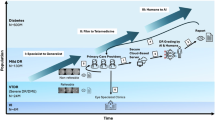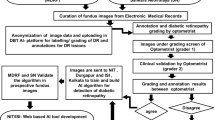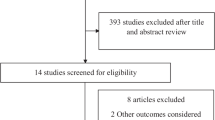Abstract
Diabetes is a global eye health issue. Given the rising in diabetes prevalence and ageing population, this poses significant challenge to perform diabetic retinopathy (DR) screening for these patients. Artificial intelligence (AI) using machine learning and deep learning have been adopted by various groups to develop automated DR detection algorithms. This article aims to describe the state-of-art AI DR screening technologies that have been described in the literature, some of which are already commercially available. All these technologies were designed using different training datasets and technical methodologies. Although many groups have published robust diagnostic performance of the AI algorithms for DR screening, future research is required to address several challenges, for examples medicolegal implications, ethics, and clinical deployment model in order to expedite the translation of these novel technologies into the healthcare setting.
摘要:
糖尿病为全球性的眼科健康问题, 随着糖尿病患病率的增加以及人口老龄化, 对糖尿病患者进行糖尿病视网膜病变(DR)的筛查已成为重大挑战。很多团队采用了人工智能(AI)的方法, 利用机器学习(ML)和深度学习(DL)技术开发自动检测DR的算法。本文介绍了现已报道的最先进的AI筛查DR技术, 其中一些已经商业化。这些技术都是利用不同的训练数据集和技术方法设计的。尽管许多团队的研究表明AI算法用于筛查DR具有强大的诊断性能, 但未来的研究仍面临诸多挑战, 例如对法医学的影响, 加速这些新技术向医疗机构转化所涉及的伦理学和临床部署模式等等。
Similar content being viewed by others
Login or create a free account to read this content
Gain free access to this article, as well as selected content from this journal and more on nature.com
or
Change history
10 December 2019
A Correction to this paper has been published: https://doi.org/10.1038/s41433-019-0728-0
References
World Health Organization. Global report on diabetes. World Health Organization; 2016.
Zheng Y, He M, Congdon N. The worldwide epidemic of diabetic retinopathy. Indian J Ophthalmol. 2012;60:428.
Yau JW, Rogers SL, Kawasaki R, Lamoureux EL, Kowalski JW, Bek T, et al. Global prevalence and major risk factors of diabetic retinopathy. Diabetes Care. 2012;35:556–64.
Liew G, Michaelides M, Bunce C. A comparison of the causes of blindness certifications in England and Wales in working age adults (16–64 years), 1999–2000 with 2009–2010. BMJ Open. 2014;4:e004015.
Pieczynski J, Grzybowski A. Review of diabetic retinopathy screening methods and programmes adopted in different parts of the world. European Ophthalmic Review. 2015;9:49–55.
Mohammadpour M, Heidari Z, Mirghorbani M, Hashemi H. Smartphones, tele-ophthalmology, and VISION 2020. Int J Ophthalmol. 2017;10:1909.
LeCun Y, Bengio Y, Hinton G. Deep learning. Nature. 2015;521:436.
Lakhani P, Sundaram B. Deep learning at chest radiography: automated classification of pulmonary tuberculosis by using convolutional neural networks. Radiology. 2017;284:574–82.
Esteva A, Kuprel B, Novoa RA, Ko J, Swetter SM, Blau HM, et al. Dermatologist-level classification of skin cancer with deep neural networks. Nature. 2017;542:115.
Gulshan V, Peng L, Coram M, Stumpe MC, Wu D, Narayanaswamy A, et al. Development and validation of a deep learning algorithm for detection of diabetic retinopathy in retinal fundus photographs. JAMA. 2016;316:2402–10.
Raumviboonsuk P, Krause J, Chotcomwongse P, Sayres R, Raman R, Widner K, et al. Deep learning versus human graders for classifying diabetic retinopathy severity in a nationwide screening program. npj Digit Med. 2019;2:25.
Ting DSW, Cheung CY-L, Lim G, Tan GSW, Quang ND, Gan A, et al. Development and validation of a deep learning system for diabetic retinopathy and related eye diseases using retinal images from multiethnic populations with diabetes. JAMA. 2017;318:2211–23.
Kermany DS, Goldbaum M, Cai W, Valentim CC, Liang H, Baxter SL, et al. Identifying medical diagnoses and treatable diseases by image-based deep learning. Cell. 2018;172:1122–31. e9.
De Fauw J, Ledsam JR, Romera-Paredes B, Nikolov S, Tomasev N, Blackwell S, et al. Clinically applicable deep learning for diagnosis and referral in retinal disease. Nat Med. 2018;24:1342.
Abramoff MD, Staal J, Suttorp MSA, Polak BC, Viergever MA. Low level screening of exudates and hemorrhages in background diabetic retinopathy. Comp. Assist. Fundus Image Anal. 2000;15.
Abràmoff MD, Lou Y, Erginay A, Clarida W, Amelon R, Folk JC, et al. Improved automated detection of diabetic retinopathy on a publicly available dataset through integration of deep learning. Invest Ophthalmol Vis Sci. 2016;57:5200–6.
Abràmoff MD, Lavin PT, Birch M, Shah N, Folk JC. Pivotal trial of an autonomous AI-based diagnostic system for detection of diabetic retinopathy in primary care offices. npj Digit Med. 2018;1:39.
Abràmoff MD, Folk JC, Han DP, Walker JD, Williams DF, Russell SR, et al. Automated analysis of retinal images for detection of referable diabetic retinopathy. JAMA Ophthalmol. 2013;131:351–7.
Hansen MB, Abràmoff MD, Folk JC, Mathenge W, Bastawrous A, Peto T. Results of automated retinal image analysis for detection of diabetic retinopathy from the Nakuru Study, Kenya. PLoS ONE. 2015;10:e0139148.
van der Heijden AA, Abramoff MD, Verbraak F, van Hecke MV, Liem A, Nijpels G. Validation of automated screening for referable diabetic retinopathy with the IDx‐DR device in the Hoorn Diabetes Care System. Acta Ophthalmol (Copenh). 2018;96:63–8.
US Food and Drug Administration. FDA permits marketing of artificial intelligence-based device to detect certain diabetes-related eye problems. News Release, US Food and Drug Administration; April 2018.
Ribeiro L, Oliveira CM, Neves C, Ramos JD, Ferreira H, Cunha-Vaz J. Screening for diabetic retinopathy in the central region of Portugal. Added value of automated ‘disease/no disease’ grading. Ophthalmologica. 2015;233:96–103.
Ribeiro ML, Nunes SG, Cunha-Vaz JG. Microaneurysm turnover at the macula predicts risk of development of clinically significant macular edema in persons with mild nonproliferative diabetic retinopathy. Diabetes Care. 2012;36:1254–9.
Pappuru RK, Ribeiro L, Lobo C, Alves D, Cunha-Vaz J. Microaneurysm turnover is a predictor of diabetic retinopathy progression. Br J Ophthalmol. 2018;103:222–6.
Haritoglou C, Kernt M, Neubauer A, Gerss J, Oliveira CM, Kampik A, et al. Microaneurysm formation rate as a predictive marker for progression to clinically significant macular edema in nonproliferative diabetic retinopathy. Retina. 2014;34:157–64.
Leicht SF, Kernt M, Neubauer A, Wolf A, Oliveira CM, Ulbig M, et al. Microaneurysm turnover in diabetic retinopathy assessed by automated RetmarkerDR image analysis-potential role as biomarker of response to ranibizumab treatment. Ophthalmologica. 2014;231:198–203.
Kim ST, Jeong WJ. Microaneurysm turnover after the use of dexamethasone and bevacizumab to treat diabetic macular edema. J Korean Ophthalmol Soc. 2018;59:332–7.
Tufail A, Kapetanakis VV, Salas-Vega S, Egan C, Rudisill C, Owen CG, et al. An observational study to assess if automated diabetic retinopathy image assessment software can replace one or more steps of manual imaging grading and to determine their cost-effectiveness. Health Technol Assess (Rockv). 2016;20:1–72. xxviii
Solanki K, Ramachandra C, Bhat S, Bhaskaranand M, Nittala MG, Sadda SR. EyeArt: automated, high-throughput, image analysis for diabetic retinopathy screening. Invest Ophthalmol Vis Sci. 2015;56:1429.
Rajalakshmi R, Subashini R, Anjana RM, Mohan V. Automated diabetic retinopathy detection in smartphone-based fundus photography using artificial intelligence. Eye. 2018;32:1138.
Bawankar P, Shanbhag N, Dhawan B, Palsule A, Kumar D, Chandel S, et al. Sensitivity and specificity of automated analysis of single-field non-mydriatic fundus photographs by Bosch DR Algorithm—Comparison with mydriatic fundus photography (ETDRS) for screening in undiagnosed diabetic retinopathy. PLoS ONE. 2017;12:e0189854.
Larsen N, Godt J, Grunkin M, Lund-Andersen H, Larsen M. Automated detection of diabetic retinopathy in a fundus photographic screening population. Invest Ophthalmol Vis Sci. 2003;44:767–71.
Hansen AB, Hartvig NV, Jensen MS, Borch‐Johnsen K, Lund‐Andersen H, Larsen M. Diabetic retinopathy screening using digital non‐mydriatic fundus photography and automated image analysis. Acta Ophthalmol Scand. 2004;82:666–72.
Larsen M, Godt J, Larsen N, Lund-Andersen H, Sjølie AK, Agardh E, et al. Automated detection of fundus photographic red lesions in diabetic retinopathy. Invest Ophthalmol Vis Sci. 2003;44:761–6.
Gargeya R, Leng T. Automated identification of diabetic retinopathy using deep learning. Ophthalmology. 2017;124:962–9.
Li Z, Keel S, Liu C, He Y, Meng W, Scheetz J, et al. An automated grading system for detection of vision-threatening referable diabetic retinopathy on the basis of color fundus photographs. Diabetes Care. 2018;41:2509–16.
Wong TY, Sun J, Kawasaki R, Ruamviboonsuk P, Gupta N, Lansingh VC, et al. Guidelines on diabetic eye care: the International Council of Ophthalmology Recommendations for screening, follow-up, referral, and treatment based on resource settings. Ophthalmology. 2018;125:1608–22.
Author information
Authors and Affiliations
Corresponding author
Ethics declarations
Conflict of interest
The authors declare that they have no conflict of interest. GL and DT are the co-inventors of a deep learning system for retinal diseases. MA is the inventor on patents and patent applications of artificial intelligence and machine learning algorithms for diagnosis and treatment. He is a Founder CEO, employee, of and investor in IDx, Coralville, Iowa, USA.
Additional information
Publisher’s note: Springer Nature remains neutral with regard to jurisdictional claims in published maps and institutional affiliations.
Rights and permissions
About this article
Cite this article
Grzybowski, A., Brona, P., Lim, G. et al. Artificial intelligence for diabetic retinopathy screening: a review. Eye 34, 451–460 (2020). https://doi.org/10.1038/s41433-019-0566-0
Received:
Accepted:
Published:
Issue Date:
DOI: https://doi.org/10.1038/s41433-019-0566-0
This article is cited by
-
The evolution of diabetic retinopathy screening
Eye (2025)
-
Artificial intelligence assisted clinical fluorescence imaging achieves in vivo cellular resolution comparable to adaptive optics ophthalmoscopy
Communications Medicine (2025)
-
Evolution of ophthalmological care in adult with diabetes in France between 2010 and 2022: a nationwide study
Graefe's Archive for Clinical and Experimental Ophthalmology (2025)
-
Diagnostic Accuracy of Automated Diabetic Retinopathy Image Assessment Software: IDx-DR and RetCAD
Ophthalmology and Therapy (2025)
-
Image quality assessment of retinal fundus photographs for diabetic retinopathy in the machine learning era: a review
Eye (2024)



